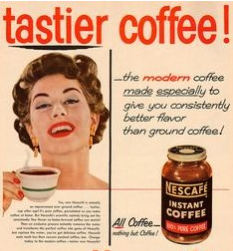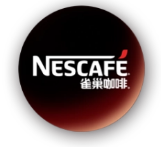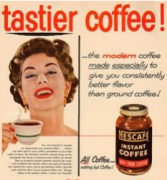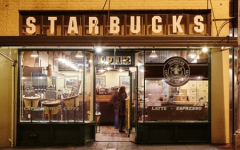Coffee history-the history of instant coffee, instant coffee production process and origin.
In the modern history of coffee, the earliest wave of recommended coffee development is the instant melting of coffee.
The invention of instant coffee was invented and patented by New Zealander David Strang in 1890. In 1901, Satori Kato, a Japanese-American chemist, created instant mixed coffee. In 1938, Max Morgenthaler spent seven years perfecting its freeze-dried instant coffee, which gave birth to Nestle Coffee. Nestle Coffee benefits here, and the company is growing rapidly. The popularity of instant coffee was during World War II. Because of its refreshing effect, the US military incorporated coffee into military materials. Later, when World War II was won, soldiers thought that coffee played an important role in it. So they retained the habit of drinking coffee and brought it back to daily life. With the introduction of commercials on American television stations, sales of instant coffee have also skyrocketed. At that time, coffee gradually became a necessity in people's lives.

"Nestle Coffee" is the first instant coffee brand in the world, which has a long history and heritage. In the past 83 years, Nestle Coffee has grown from a can of coffee to today's comprehensive product range and system. Nestle coffee is sold in more than 180 countries around the world, and it leads the trend of coffee beverage category. In October 2019, Interbrand ranked 38th in the list of the top 100 global brands.
Back in 1929, Louis Dapples, then chairman of Nestle Group, received a request for help from his former employer, the Banque Fran ç aise et Italienne pour l'am é rique du Sud. At the time, following the Wall Street crash and the collapse of coffee prices, the bank had a lot of excess coffee in its warehouses in Brazil.
What needs to be done is whether Nestl é can turn these stocks into "soluble solid coffee" for sale. To this end, chemist Max Max Morgenthaler joined the Nestl é team to work with researchers to find a solution. After three years of research, they found that milk coffee (caf é au lait)-coffee mixed with milk and sugar, and then converted into powder, can stay mellow for a longer time. At that time, however, the powdered particles were not easy to dissolve, and milk and sugar also added challenges to production.
Dr Morgentel found that coffee preserved in sweet milk tastes better and tastes better than unsweet milk. He also found that coffee exposed to high temperature and high pressure lasted longer.
This was a pioneering work at that time, which was very different from the thinking of the public. A year later, he used a special process to produce powdered particles that met this requirement and provided samples of soluble coffee to the Nestle Executive Committee and the Technical Director.
Two years later, on April 1, 1938, the soluble coffee product, called Nestle Coffee, was launched in Switzerland. Nestl é has set up a large-scale production line for coffee extraction and "spray drying" of coffee beans to produce Nestle coffee at its factory in the small Swiss city of Orbe. Two months later, the Nestle Coffee brand was launched in the UK and then in the United States in 1939. By April 1940, Nestle coffee had been sold in 30 countries around the world.

At that time, a large amount of Nestle coffee production was used for U. S. military supplies.
Important Notice :
前街咖啡 FrontStreet Coffee has moved to new addredd:
FrontStreet Coffee Address: 315,Donghua East Road,GuangZhou
Tel:020 38364473
- Prev

The definition and Development History of Fine Coffee beans how to brew Arabica Coffee beans
The boutique of modern coffee can be divided into three stages; the first wave (1940-1960): the key word of this stage is the creation of instant coffee. In 1890, New Zealander DavidStrang invented the earliest instant coffee and registered its patent. 1901, Japanese-American
- Next

Coffee history-the high-quality process of coffee tide, Starbucks coffee originated from the development process.
What has happened to the boutique of coffee? After the era of instant coffee, when the first wave of coffee gradually dissipated, several Europeans were slowly changing the American taste of boutique coffee, the godfather Alfred Peet and the godmother Erna Knutsen. Mr. Peet promotes his deep-roasted coffee beans, Alfred Peet, a Dutch coffee, on the west coast of the United States.
Related
- Beginners will see the "Coffee pull flower" guide!
- What is the difference between ice blog purified milk and ordinary milk coffee?
- Why is the Philippines the largest producer of crops in Liberia?
- For coffee extraction, should the fine powder be retained?
- How does extracted espresso fill pressed powder? How much strength does it take to press the powder?
- How to make jasmine cold extract coffee? Is the jasmine + latte good?
- Will this little toy really make the coffee taste better? How does Lily Drip affect coffee extraction?
- Will the action of slapping the filter cup also affect coffee extraction?
- What's the difference between powder-to-water ratio and powder-to-liquid ratio?
- What is the Ethiopian local species? What does it have to do with Heirloom native species?

